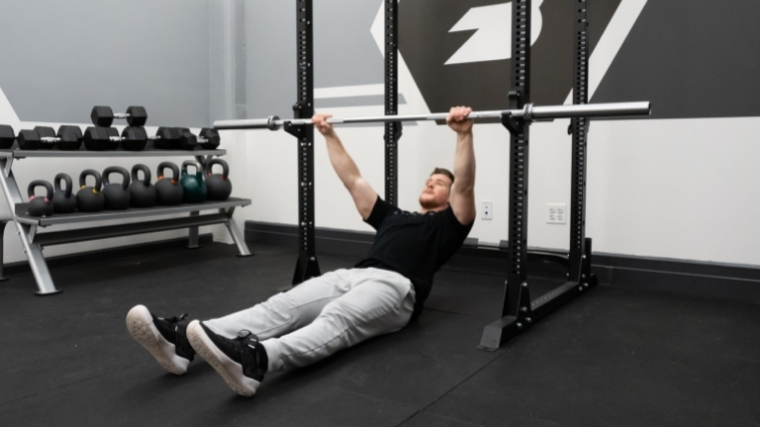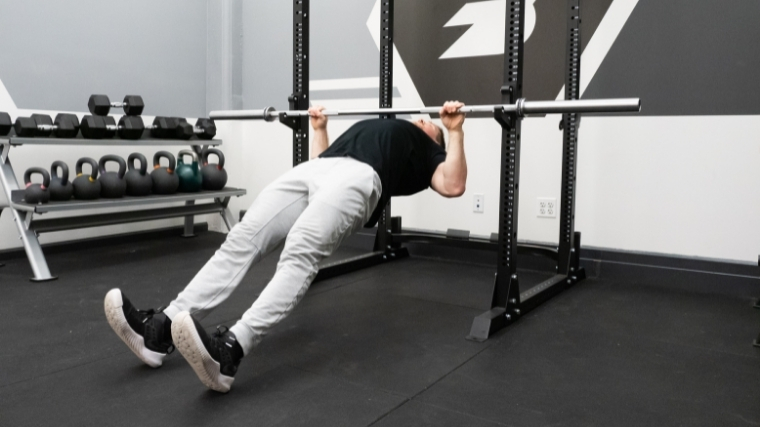The pull-up gets a lot of credit for being the ultimate back-building exercise. We’re not going to dispute that claim. But if you’re the type of lifter to shrug off inverted rows as a weakling’s pull-up — well, you need to rethink your approach to back training.
When it comes to building a strong back, the inverted row is arguably one of the best exercises a lifter can do. Just because it’s easier to perform than a pull-up doesn’t make it less effective. Because you can do more reps, the inverted row is a great move to add muscle to your back. If you aren’t ready for pull-ups, then it can help you get ready for them. And because you’re in what’s essentially an upside-down plank, your core will get stronger.
Below, we’ll teach you how to do an inverted row, outline the move’s benefits, variations, and provide set and rep recommendations.
- How to Do the Inverted Row
- Benefits of the Inverted Row
- Muscles Worked by the Inverted Row
- Who Should Do the Inverted Row
- Inverted Row Sets, Reps, and Programming Recommendations
- Inverted Row Variations
- Inverted Row Alternatives
- Frequently Asked Questions
Inverted Row Video Guide
Check out our in-depth video featuring former Training Editor Jake Boly.
[Related: The Best Barbells For CrossFit, Weightlifting, Powerlifting, Deadlifts, and More]
How to Do the Inverted Row
The below step-by-step guide explains how to perform the inverted row. Specifically, the inverted row done with a barbell positioned in a power rack.
Step 1 — Get Under a Barbell
Lay a barbell across the J cups of a power rack. Set it high enough so when you grab the bar with both hands and extend your arms and legs, your body isn’t touching the floor. If you’re using a Smith machine, adjust the barbell to the correct height.
Lay underneath the bar, so it’s in line with your chest. Grab the bar with a grip that’s slightly wider than shoulder-width. Extend your legs in front of you, keeping your butt on the floor.
Form Tip: If you’re having trouble finding a grip, use the hand placement that you would for bent-over barbell rows.
Step 2 — Row Your Chest to the Bar
Raise your butt off the ground and create a straight line from your head to your toes. If you were to flip your stomach down, you should look like you’re in a plank position. Pull with your arms and squeeze your shoulder blades together to row your chest to the bar.
Form Tip: Drive the elbows to the ground and think “lead with the chest.”
Step 3 — Contract and Descend
Once your chest touches the bar, hold this position for a second and then slowly lower yourself back down.
Form Tip: Lower the body in a controlled fashion, maintain postures at the bottom, and repeat the process.
Benefits of the Inverted Row
Below are three benefits of the inverted row that strength, power, and fitness athletes can benefit from.
Easily Scaled and Progressed for All Levels
The inverted row is a great exercise for all fitness levels, as it can be easily scaled to fit the complete beginner to the most advanced lifter. Modifying the movement during a set also makes it a great exercise to drive training intensity and achieve failure. By simply having a lifter walk themselves under the bar more or prop their feet up onto a bench (see the variations section below), you can increase the strength demands without adding any external load.
More Back Muscle
The muscle-building benefits of the inverted row are a result of volume, not load. (Though, if you’re a big person, then you’re still technically rowing a decent amount of weight). Because it’s a bodyweight movement, you can pump out many reps for more time under tension. And because you’re not using and weight to increase back strength or your tax your grip, it’s generally easier on your joints.
Bodyweight Strength
The inverted row requires body awareness, grip strength, and core stability. This is a great way to reinforce each of those modalities with new lifters and to help bridge the gap between machines, free weights, and bodyweight training. If you struggle with pull-ups or chin-ups, you can use these to condition the body and nervous system to the demands of the pull-up in a progressive manner.
Muscles Worked by the Inverted Row
The inverted row is an upper body exercise that you can do to add strength and muscle mass to the back. That said, it may also add some volume to the biceps and forearms as well.

[Related: Best Pre-Workout Supplements for Strength, Cardio, and More]
Lats
The lats are a large triangular muscle that spans the entire length of your back. A strong back helps you in nearly every single endeavor as a lifter. Stronger back muscles — which also include your traps and rhomboids — also let you maintain better posture.
Biceps
The biceps assist the back muscles during most pulling exercises. If a lifter feels they are pulling only with their arms and not feeling the back muscles contracting, have them perform some tempo inverted rows or inverted rows where they hold themselves at the top. This tweak will place more tension on the back.
Forearms
The forearms can be trained and conditioned during the inverted row, as the lifter must support their body weight as they hold onto the barbell. This is specific to other movements as well, such as pull-ups, chin-ups, or climbing.
Who Should Do the Inverted Row?
The inverted row can be used by strength, power, and fitness athletes to increase upper body strength, back hypertrophy, and grip performance.
Strength and Power Athletes
- Powerlifters, Strongmen, and Weightlifters: The inverted row can be a great exercise to build back and grip strength and muscular conditioning (from all high reps). Strongmen and powerlifters are often loaded with muscle and therefore weigh more. As a result, pull-ups, which have you support 100 percent of your body weight, may be too challenging. Enter the inverted row, which works the same muscles but recruits less of your mass.
General and Functional Fitness
The inverted row is a great movement to help address back strength and bodyweight pulling skills, especially for lifters who struggle with pull-ups or cannot do them in high volume.
Inverted Row Sets, Reps, and Programming Recommendations
Here are three ways to program the inverted row into your training regimen.
To Gain Muscle
The key here is to focus on the muscle contractions rather than just mindlessly moving weights. Additionally, the loads themselves do not need to be heavy to affect. Start by performing three to five sets of eight to 15 reps, with 90-120 second rest periods with moderate to heavy loads.
To Gain Strength
If you’re looking to really strengthen this area, then there are better moves for the job. Try deadlifts, dumbbell rows, and Pendlay rows. All of these exercises allow you to lift more weight. That said, you can implement tempo training and more reps to reinforce back strength with the inverted row. Do three to five sets of five to 10 repetitions with 90-120 second rest periods with moderate to heavy loads.
To Improve Muscle Endurance
Competitive fitness athletes, such as CrossFitters, need the muscular endurance to perform hundreds — literally hundreds — of reps of kipping pull-ups and other back-focused movements. Do two to three sets of 20-30 repetitions with 45-60 second rest with light to moderate loads.
Inverted Row Variations
Below are three inverted row variations to improve strength, size, and overall muscle growth of the chest, triceps, and upper body.
Legs-Bent Inverted Row
The true beginner will benefit by bending their legs 90 degrees at the knee. By bending your legs, you reduce the range of motion and limit the percentage of your own bodyweight that you’re lifting. This is also, generally, a more stable position.
[Related: The Best Bumper Plates for Competition CrossFit, and More]
Tempo Inverted Row
This is just a standard legs-extended inverted row, but you perform reps to a set tempo. Try a three-second lifting phase, a one-second pause at the top, and a three-second lowering phase. You won’t be able to perform as many reps — try for six to eight — but the overall time-under-tension will be about the same as a standard high-rep set (say 15 reps).
Feet-Elevated Inverted Row
To do this variation, elevate your feet on a training bench or plyo box. This is the opposite of the legs-bent inverted row, as the elevation increases your range of motion and makes you lift more of your weight. This is tough; don’t be fooled.
[Related: The Best Kettlebells for Beginners, CrossFit, and Cardio]
Inverted Row Alternatives
Like most movements, there are multiple exercises that you can substitute for similar effects. Below, we provide two alternatives that are similar to the inverted row and will warrant consistent adaptations.
TRX Inverted Row
No rack? No problem. Grab a pair of TRX handles and loop them around the top of any sturdy machine in the gym that can support your weight — like a cable machine or pull-up bar. What’s really nice about this variation is that you can adjust the difficulty even more quickly than the typical barbell version. To do so, move your feet either closer or further away from the anchor point.
[Related: Best Dumbbells for Durability, Adjustability, Premium Options, and More]
Chest-Supported Row
The incline chest supported row is a great alternative to the inverted row. By supporting your chest on an incline bench, you take the momentum out of the equation and can focus solely on your back muscles.
[Related: The 8 Best Barbell Exercises for Mass, Strength, and Power]
FAQs
Is there a substitute for inverted rows at home?
When looking to do inverted rows at home, you first need to find a stable base to support your body weight when pulling. This can be a beam or even a table (assuming it is sturdy and will not flip over). You would perform the same inverted row as discussed above.
Another option is to use something like the TRX system and set it up in the door jam. You can also throw a rope around a sturdy tree branch or playground swing set beam.
Can inverted rows help build pull-up strength?
Yes. Inverted rows can grip, arm, and back strength. The angle is different from the pull-up (which is a vertical pulling movement). However, developing basic strength and muscle endurance in the inverted row can help increase one’s ability to train the pull-up more frequently and effectively.
How heavy can I train inverted rows?
You can train the inverted row as heavy as you want as long as you maintain good form. To load the inverted row, place your feet on a plyo box and then have a partner place a weight plate on your lap. Then carefully perform the inverted row as explained above.


